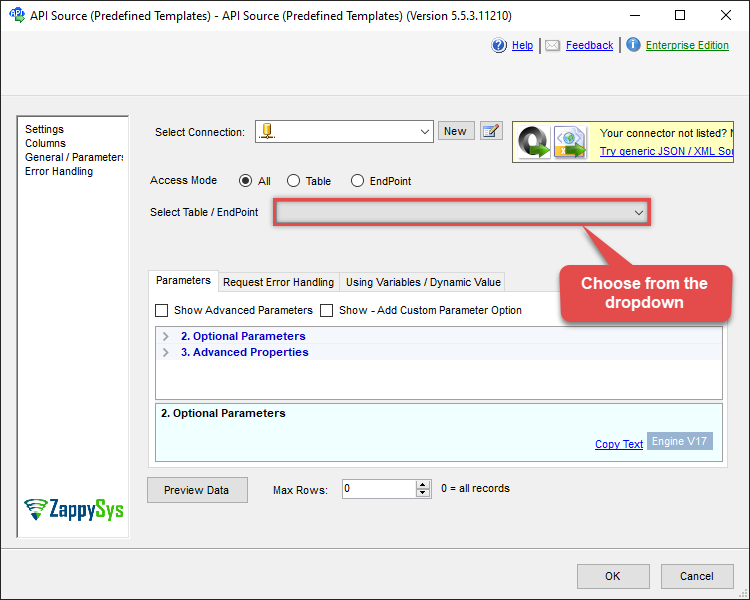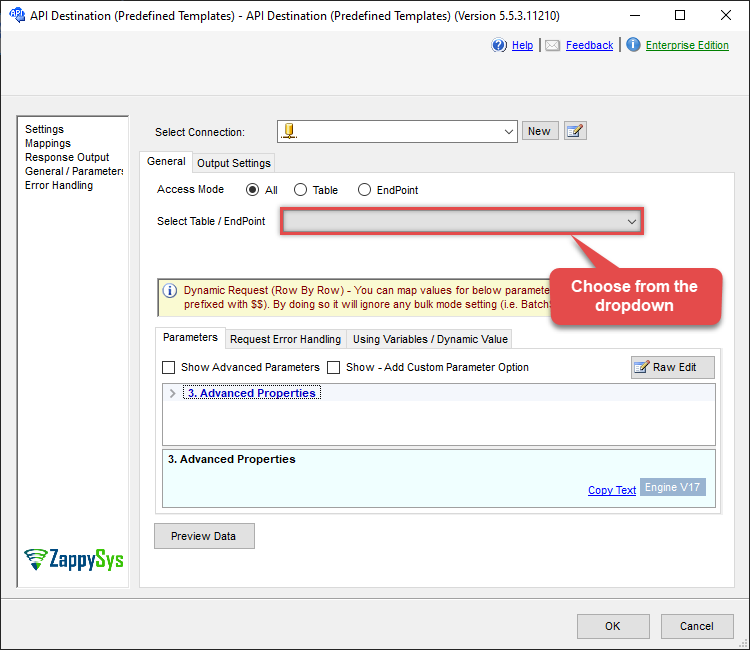Endpoint Duplicate a file
Name
copy_file
Description
Duplicates a file [API reference]
Parameters
| Parameter | Required | Options | ||||||
|---|---|---|---|---|---|---|---|---|
|
Name:
Label: Drive Type Default search context is User's drive. Bodies of items (files/documents) to which the query applies. Supported bodies are 'user', 'domain', 'drive', and 'allDrives'. Prefer 'user' or 'drive' to 'allDrives' for efficiency. By default, corpora is set to 'user'. However, this can change depending on the filter set through the 'Query' parameter. |
YES |
|
||||||
|
Name:
Label: File Id Id of a file you want to duplicate |
||||||||
|
Name:
Label: Shared DriveId By default file lists from MyDrive but if you like to search other Shared drive (formally known as Team drive) then set this parameter. |
||||||||
|
Name:
Label: Supports all drives (e.g. My and Shared) Whether the requesting application supports both My Drives and shared drives. |
|
Output Columns
| Label | Data Type (SSIS) | Data Type (SQL) | Length | Description |
|---|---|---|---|---|
| Id |
DT_WSTR
|
nvarchar(440)
|
440 | |
| Kind |
DT_WSTR
|
nvarchar(200)
|
200 | |
| Name |
DT_WSTR
|
nvarchar(780)
|
780 | |
| MimeType |
DT_WSTR
|
nvarchar(650)
|
650 | |
| CreatedTime |
DT_DBTIMESTAMP
|
datetime
|
||
| ModifiedTime |
DT_DBTIMESTAMP
|
datetime
|
||
| Size |
DT_WSTR
|
nvarchar(100)
|
100 | |
| Version |
DT_WSTR
|
nvarchar(200)
|
200 | |
| Shared |
DT_BOOL
|
bit
|
||
| Starred |
DT_BOOL
|
bit
|
||
| Trashed |
DT_BOOL
|
bit
|
||
| FileExtension |
DT_WSTR
|
nvarchar(200)
|
200 | |
| DriveId |
DT_WSTR
|
nvarchar(4000)
|
4000 |
If the column you are looking for is missing, consider customizing Google Drive Connector.
Input Columns
| Label | Data Type (SSIS) | Data Type (SQL) | Length | Description | |||||||||||||||||||||||||||||||||||||||||||||||||||||||||||||||||||||||||||||||||||||||||||||||
|---|---|---|---|---|---|---|---|---|---|---|---|---|---|---|---|---|---|---|---|---|---|---|---|---|---|---|---|---|---|---|---|---|---|---|---|---|---|---|---|---|---|---|---|---|---|---|---|---|---|---|---|---|---|---|---|---|---|---|---|---|---|---|---|---|---|---|---|---|---|---|---|---|---|---|---|---|---|---|---|---|---|---|---|---|---|---|---|---|---|---|---|---|---|---|---|---|---|---|---|
| There are no Static columns defined for this endpoint. This endpoint detects columns dynamically at runtime. | |||||||||||||||||||||||||||||||||||||||||||||||||||||||||||||||||||||||||||||||||||||||||||||||||||
Examples
SSIS
Use Google Drive Connector in API Source or in API Destination SSIS Data Flow components to read or write data.
API Source
API Source - Google Drive
Read / write Google Drive data inside your app; perform many Google Drive operations without coding, just using easy to use high performance API Connector for Google Drive
Google Drive
Duplicate a file
| Optional Parameters | |
|---|---|
| File Id | |

API Destination
API Destination - Google Drive
Read / write Google Drive data inside your app; perform many Google Drive operations without coding, just using easy to use high performance API Connector for Google Drive
Google Drive
Duplicate a file
| Optional Parameters | |
|---|---|
| File Id | |

ODBC application
Use these SQL queries in your ODBC application data source:
Duplicate a file
SELECT * FROM copy_fileSQL Server
Use these SQL queries in SQL Server after you create a data source in Data Gateway:
Duplicate a file
DECLARE @MyQuery NVARCHAR(MAX) = 'SELECT * FROM copy_file';
EXEC (@MyQuery) AT [LS_TO_GOOGLE_DRIVE_IN_GATEWAY];